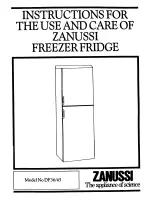
English
8
• Turn off the Fast Freeze switch once food has reached the desired temperature.
Note:
Do not forget to turn off the Fast Freeze switch when not required.
Doing so will avoid unnecessary energy use.
• When loading the freezer, freeze only three pounds of fresh food per cubic
feet of freezer space at one time.
• Distribute packages to be frozen evenly throughout the freezer.
Food Storage Basket and Divider (see fig. #2)
• A freezer basket has been provided for better organization. The removable
basket (quantity varies by model) allows
you to store food more accessibly.
Remove the basket(s) if it is
not needed.
• To reach other packages in the
freezer, just slide the basket to
one side or lift it out.
• The removable divider can be removed by lifting it out if it is not needed.
The food divider helps to better organize your food.
Lock and Key (see fig. #3)
• Your freezer may have a lock and key feature to
secure the freezer (depending on the freezer model).
Close the lid and turn the key in a clockwise direction
to lock. Turn the key in the opposite direction to unlock.
Defrosting and Draining (see fig. #4)
• For the most efficient operation and minimum energy consumption, defrost the
freezer whenever the frost becomes 1/4" thick. Never use a sharp or metallic
instrument to remove the frost, as it may damage the cooling coils and will void
your warranty. Only use the plastic scraper that is provided. Do not use boiling
water because this may damage the plastic parts.
• Remove the frozen food from the freezer and place it in
a cooler to protect the food.
• Turn the temperature control to the OFF position and unplug
the unit. The green “Power On” indicator light will turn off.
• Remove the interior drain plug from the inside of the freezer.
• Place a tray beneath the exterior drain plug. Remove the
drain plug. This will allow the defrost water to flow out into
the tray. Defrosting usually takes a few hours. To defrost
faster, keep the freezer door open.
Note:
Check the pan occasionally so that the water does not overflow.
Fig. #2
Fig. #3
Fig. #4










































